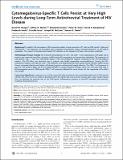| dc.contributor.author | Naeger, David M. | |
| dc.contributor.author | Martin, Jeffrey Michael | |
| dc.contributor.author | Sinclair, Elizabeth | |
| dc.contributor.author | Hunt, Peter K. | |
| dc.contributor.author | Bangsberg, David Roy | |
| dc.contributor.author | Hecht, Frederick | |
| dc.contributor.author | Hsue, Priscilla | |
| dc.contributor.author | McCune, Joseph M. | |
| dc.contributor.author | Deeks, Steven G. | |
| dc.date.accessioned | 2013-01-22T21:32:26Z | |
| dc.date.issued | 2010 | |
| dc.identifier.citation | Naeger, David M., Jeffrey N. Martin, Elizabeth Sinclair, Peter W. Hunt, David R. Bangsberg, Frederick Hecht, Priscilla Hsue, Joseph M. McCune, and Steven G. Deeks. 2010. Cytomegalovirus-specific T cells persist at very high levels during long-term antiretroviral treatment of HIV disease. PLoS ONE 5(1): e8886. | en_US |
| dc.identifier.issn | 1932-6203 | en_US |
| dc.identifier.uri | http://nrs.harvard.edu/urn-3:HUL.InstRepos:10206253 | |
| dc.description.abstract | Background: In healthy, HIV seronegative, CMV seropositive adults, a large proportion of T cells are CMV-specific. High-level CMV-specific T cell responses are associated with accelerated immunologic aging (‘‘immunosenesence’’) in the elderly population. The impact of untreated and treated HIV infection on the frequency of these cells remains undefined. Methodology/Principal Findings: We measured the proportion of CD4+ and CD8+ T cells responding to CMV pp65 and IE proteins was measured using flow cytometry in 685 unique HIV seronegative and seropositive individuals. The proportion of CMV-specific CD8+ T cells was consistently higher in the HIV-seropositive subjects compared to the HIV-seronegative subjects. This HIV effect was observed even in patients who lacked measurable immunodeficiency. Among the HIV-seropositive subjects, CMV-specific CD8+ T cell responses were proportionately lower during recent infection, higher during chronic untreated infection and higher still during long-term antiretroviral treated infection. The CD8+ T cell response to just two CMV proteins (pp65 and IE) was approximately 6% during long-term therapy, which was over twice that seen in HIV-seronegative persons. CMV-specific CD4+ T cell responses followed the same trends, but the magnitude of the effect was smaller. Conclusions/Significance: Long-term successfully treated HIV infected patients have remarkably high levels of CMV-specific effector cells. These levels are similar to that observed in the elderly, but occur at much younger ages. Future studies should focus on defining the potential role of the CMV-specific inflammatory response in non-AIDS morbidity and mortality, including immunosenescence. | en_US |
| dc.language.iso | en_US | en_US |
| dc.publisher | Public Library of Science | en_US |
| dc.relation.isversionof | doi://10.1371/journal.pone.0008886 | en_US |
| dc.relation.hasversion | http://www.ncbi.nlm.nih.gov/pmc/articles/PMC2813282/pdf/ | en_US |
| dash.license | LAA | |
| dc.subject | immunology | en_US |
| dc.subject | immune response | en_US |
| dc.subject | infectious diseases | en_US |
| dc.subject | HIV infection and AIDS | en_US |
| dc.title | Cytomegalovirus-Specific T Cells Persist at Very High Levels during Long-Term Antiretroviral Treatment of HIV Disease | en_US |
| dc.type | Journal Article | en_US |
| dc.description.version | Version of Record | en_US |
| dc.relation.journal | PLoS ONE | en_US |
| dash.depositing.author | Bangsberg, David Roy | |
| dc.date.available | 2013-01-22T21:32:26Z | |
| dash.affiliation.other | HMS^Medicine-Massachusetts General Hospital | en_US |
| dc.identifier.doi | 10.1371/journal.pone.0008886 | * |
| dash.contributor.affiliated | Martin, Jeffrey Michael | |
| dash.contributor.affiliated | Hunt, Peter | |
| dash.contributor.affiliated | Bangsberg, David R. | |


